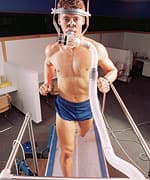Life Extension Magazine®
Q:I am a healthy 55-year-old woman. Although I thought I was in excellent physical condition, I recently had a bone density test and the doctor told me that I have the “spine of a 70-year-old woman.” What are the implications of this finding for my overall health and my “true age”? Are there other tests I should consider taking or strategies I can pursue to arrest this kind of premature aging? A: Many people are surprised by this kind of diagnosis, and I believe it is because our culture suffers from a fundamental misunderstanding of aging itself. Age is not merely a matter of birthdays or the passage of years. Medically speaking, age is a measure of how well your organs and major systems are functioning. Age can vary wildly, even within a particular individual. In this case, for example, despite being 55 years old, you might have the heart of a 40-year-old and the spine of a 70-year-old. So how old am I really, you might ask. The bad news is that, in terms of aging, you are 70. Each person is only as young as their oldest part. “You Are Only as Young as Your Oldest Part”I will address the spinal issues in a moment, but first it is important to address the concept of aging. Most people are familiar with the idea that a chain is only as strong as its weakest link. This same concept applies if you think of your body as a chain of interrelated systems that work together to support life and youthful vigor. In other words, you are only as young as your oldest body system. The reasoning behind this notion is that your quality of life can be ruined by a disorder of just one bodily system. Let us say, for example, that you develop severe osteoporosis in the near future. You would be at risk for fractures in your hips and vertebrae, which may result in pain, loss of mobility, and permanent curvature of the spine. At this point, your dominant health concern is the deterioration of your bones, not the relative health of your other organs. Thus, you are as old as your weakest part. But even this picture is too simplistic. To truly understand aging and disease, we have to drill down into the causes of disease. Osteoporosis, for example, is most commonly a hormone-mediated loss of bone density, frequently in conjunction with declining estrogen levels that occur after a woman reaches menopause, around the age of 50 or so. Specifically, bone destruction, which is a normal metabolic process, begins to occur more rapidly than bone rebuilding. This process is regulated in part by estrogen, which, along with vitamin D and other nutrients, plays an important role in calcium uptake into bone. Other factors that play a part are the presence of thyroid hormones, testosterone, and adrenal hormones, as well as weight-bearing exercise. Using this broad understanding of osteoporosis, you can see how it is actually the product of an imbalanced hormonal system. In this context, we can begin to see that osteoporosis is the outward manifestation of a deeper problem with the brain, which produces or regulates about 90% of our hormones. The influence of hormones on brain function is well established. As hormone levels decline, the brain no longer operates at peak efficiency. This causes stress in the body, depending on which hormone is in short supply and the particular biology of each individual. This imbalance may manifest itself as osteoporosis, but it may also show up as cognitive deficiencies, mood disorders, metabolic disorders, fatigue, or sexual dysfunction. For example, patients with osteoporosis often have reduced memory and increased anxiety and depression.
Let us take this even one step further to understand why having the spine of a 70-year-old may be a signal of other serious health concerns. Say, for example, that a patient exhibits hormone-mediated stress. This causes the body to release stress chemicals into the blood that raise blood pressure and increase the heart’s output. Over time, this slight hypertension has a degenerative effect on the heart, which begins to expand in response to constant low-grade stress. Before long, the patient may suffer episodes of angina or even a heart attack, and be diagnosed with heart disease. The cause of this heart disease might officially be listed as hypertension, or even idiopathic (of no known cause), but the true cause is a hormonal imbalance. I call this the “domino effect,” and it means that all our systems and organs are interrelated, which explains why we are only as young as our oldest system. A problem in one organ system is almost always closely related to significant problems elsewhere in the body. Our hearts do not beat in isolation, nor do our bones grow in a vacuum. Our livers do not function without affecting, and being affected by, all the other organs. Diagnostic Tests to Measure Aging Organ SystemsThe good news is that in recent decades, we have made tremendous advances in our ability to measure aging by evaluating specific organ systems using advanced diagnostic tests. Some of these tests include:
It is crucial that none of these is ignored, because scores of studies have shown that these states are connected to physical diseases, such as heart disease and cancer. To help patients understand how each of these systems is affected by aging, I often use the well-understood model of menopause. Almost everyone is familiar with menopause, in which a woman’s production of estrogen declines rapidly in her late forties and early fifties. Besides causing short-term symptoms, such as hot flashes, this decline in estrogen is linked to an increased risk for osteoporosis, diabetes, and other diseases of aging. Using this model, I have identified 21 other “pauses” that affect people as they age. By measuring where people are in their various stages of aging, we can turn to the next step, which is healing. A Whole-Body Approach to Premature AgingThe beauty behind a life extension concept of aging and healing is our ability to simultaneously target individual organ systems while treating the whole person. For instance, in the case of reduced bone density, we would design a program that specifically addresses this bone density issue. The therapy might include calcium and vitamin D supplements combined with exercise, just like any conventional therapy. But it would also address underlying conditions that helped give rise to the osteoporosis in the first place. This might mean the addition of bioidentical estrogens and other hormones. This sort of therapy will have a ripple effect throughout the entire body. Besides specifically addressing bone loss, it will also reduce risk for depression, obesity, and other debilitating diseases by correcting hormone deficiencies. I believe this kind of medicine is the wave of the future. Too much of our conventional therapy is driven by actuarial tables, in which disease A (heart disease, for instance) is always treated with approach B (statin therapy, for instance). This ignores any underlying conditions that may be contributing to the heart disease and may be unique to that patient. It addresses only the most obviously dysfunctional—or “oldest”—organ system, to the possible detriment of the rest of the body. In the future, we will address both the most severely damaged organ system and the underlying causes of disease for each person.
There is no doubt that nutritional supplements, balanced diet, exercise, and healthy lifestyle habits are very important tools in our fight against premature aging. Once we have identified a sick organ system, we can target underlying deficiencies with supplement programs that provide the exact amounts of nutrients needed. This program can be complemented with traditional pharmaceuticals, as well as alternative therapies such as chelation, acupuncture, meditation, and psychological counseling. No tools are off the table when it comes to treating premature aging. Dr. Eric Braverman is director of the Place for Achieving Total Health (PATH Medical) and director of the Integrative Health Program at Cabrini Medical Center, both in New York City. For more information, please visit his website at www.pathmed.com. |



